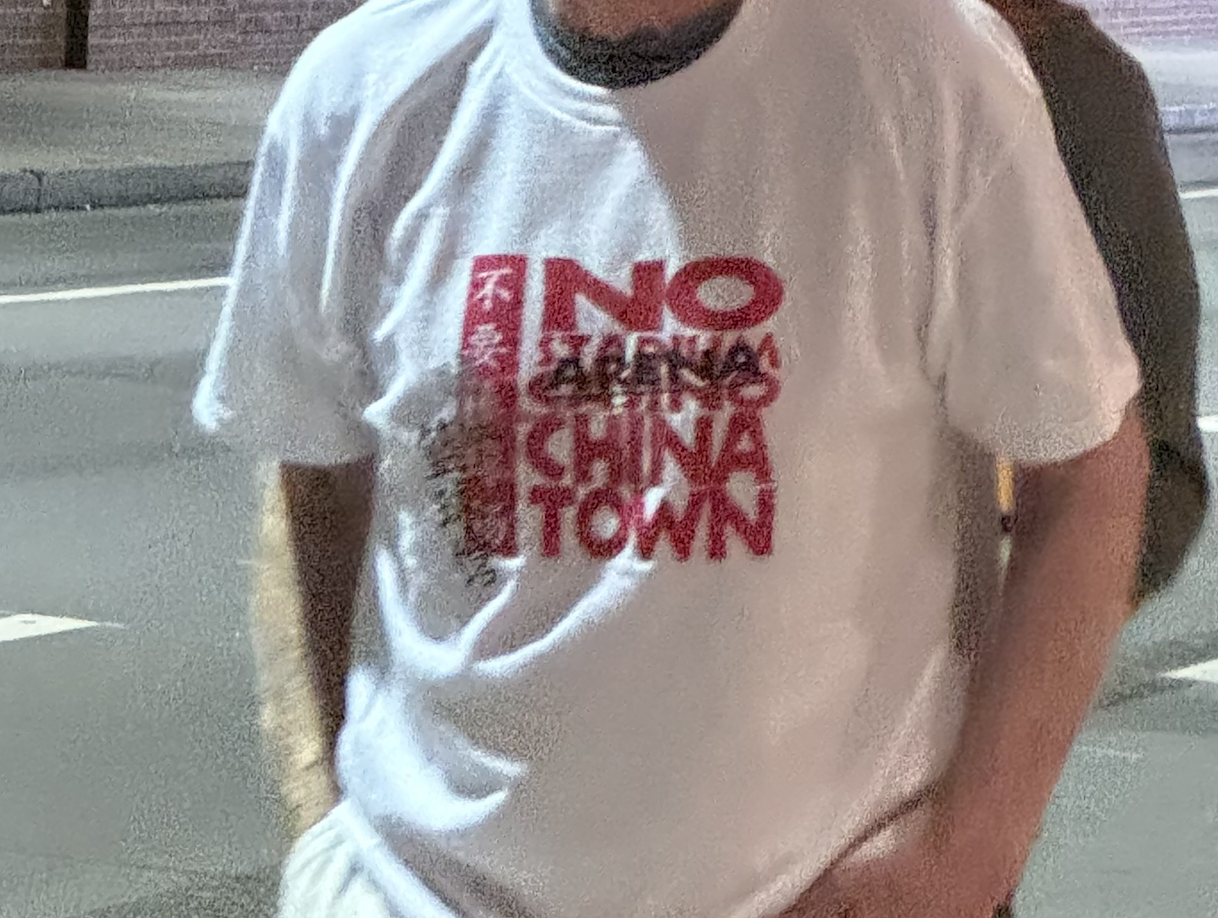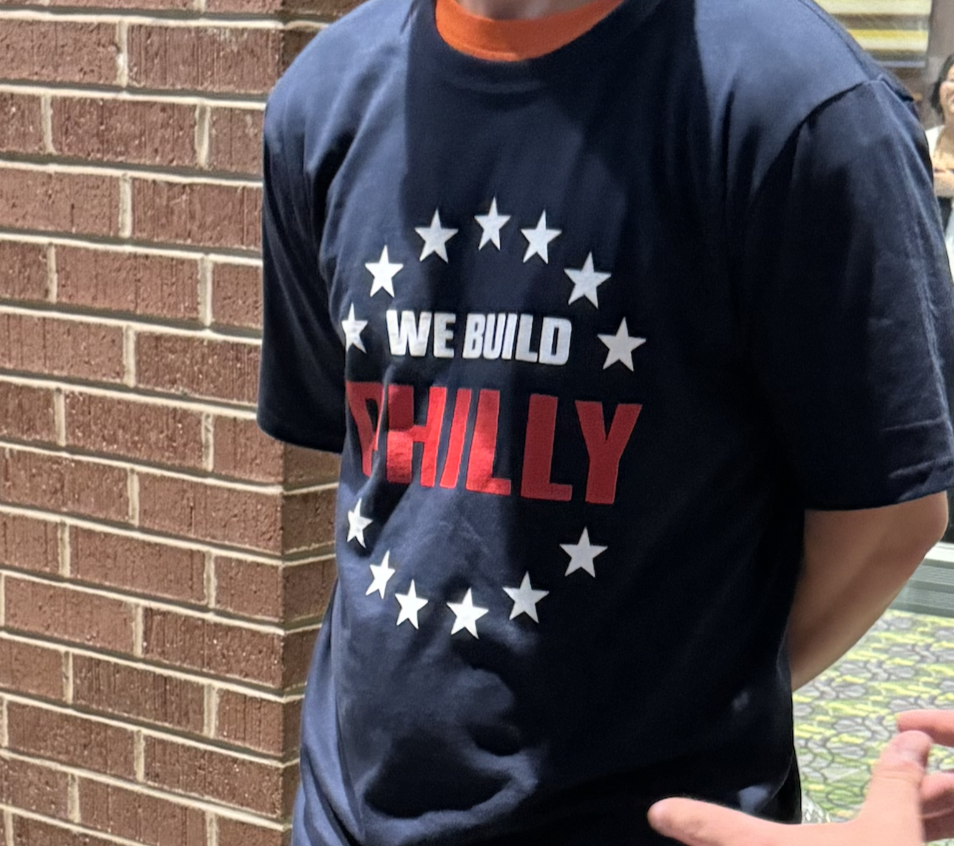The greatest compliment Mayor Cherelle Parker has received as an elected official is that she’s an active listener.
The audience that took up three rooms in the Pennsylvania Convention Center followed the leader of Wednesday’s 76 Place Town Hall.
No guest liked everything they had to hear, but they didn’t just listen for words that would appease their ears.
For every nod, there was a shaking head. For every light boo, there was a far louder applause.
The line to get into the building started under the tunnel around the corner from the Town Hall entrance. After 6 p.m., the scheduled start time, the line expanded toward Broad Street.
Though not every single voice was heard on Wednesday night, the audience was massive - and not just because of the viewers watching from home.
It felt like a majority of attendees flooded the Convention Center donning this shirt:

On the other hand, there were clusters of shirts like this:

The shirts were symbolic of the cause.
Who was in attendance? Philadelphia residents of Asian descent (not just Chinese residents); Members of the LGBTQ+ community, who are anti-arena because of the project's "predatory" nature with respect to the Gayborhood and people who don't necessarily identify with either of those two groups but are passionate about the cause.
Then, there were the union workers: janitors, engineers who manage large buildings in the area, security officers, cleaners, carpenters, electricians, construction workers and more. One union member who spoke in favor of building 76 Place in Chinatown identified this body of the audience as African-Americans, Latinos, and people of color.
There were moments of passion. The first and only person to be warned by Mayor Parker for not being respectful while a speaker was talking was anti-arena. The only person who was aggressively critical toward the mayor did not lean in favor of either side; he just wanted to deliver a message to both parties.
By and large, this meeting was not a back-and-forth between guest and host or guest and guest from either side of the matter. Rather, it was an opportunity for both parties to appeal to Mayor Parker and the city council as they make their decision.
The meeting took up three rooms, each of which was separated by walls. Mayor Parker was at the front of the first room. There were large screens at the front of each room projecting each speaker so as to create an interactive connection between all folks participating in the meeting.
Beyond the affected parties, Councilmen Mark Squilla and Jeffery Young Jr., Chief Legal Counsel for the Office of the Council for Philadelphia John Christmas, and state Senator Nikil Saval were in attendance. These elected officials were not seated up front in an effort to avoid an environment of interrogation by the meeting's participants.
After Mayor Parker's opening remarks, the findings of four impact reports were presented.
Real estate consultant BJH Advisors and Sojourner Consulting found that Chinatown faces significant but not insurmountable gentrification challenges if the arena is not built due to rising real estate values. That puts pressure on the residents and fuels competition from emerging centers in Northeast and South Philadelphia.
If the arena is built, it further stresses the existing issues, particularly for transportation and small businesses. It may result in indirect displacement.
A net benefits analysis of Chinatown businesses concluded that 50 percent of businesses were likely to be negatively impacted; 20 percent were likely to be positively impacted; the rest would experience varied impacts.
They found that Chinatown is a particularly auto-dependent community and that cultural practices influence various concerns and behaviors of those who travel to and live within the neighborhood.
Market East, the historic shopping hub, continues to face a post-pandemic transformation of the retail and office landscape. If the arena is not built, the significant challenges around safety, quality of a built environment and a weak business environment will persist.
If the arena is built, the impact will be dependent upon multiple variables. The impact on safety and the built environment will depend on the design of the project, its commercial program,and the extent to which it can serve as a catalyst for development.
Regardless of the decision on the arena, they determined that a comprehensive effort is needed to address the changing retail and office landscape in Market East.
Johnson, Mirmiran, & Thompson (JMT) found that the study done by the Sixers assumed a 40 percent auto split (and thus a 60 percent non-auto split). 40 percent of the non-auto split is comprised of transit. That was deemed attainable, although there is work to be done.
There is concern that a breaking point (gridlock; long queues of vehicles and significant delays) at major intersections would occur if more than 43 percent of people choose to drive to the arena.
So, the goal is to promote non-auto trips. JMT found that key strategies to do that included providing transit passes with every ticket and increasing the frequency of transit services, especially on evenings and weekends.
Regarding ride-hailing (Uber, Lyft, etc.), they found that the Sixers' proposal was reasonable with respect to loading and unloading zones. However, JMT identified that some of the zones in the Sixers' plan were not feasible.
In the independent review JMT conducted, they identified additional loading zones, ultimately concluding that the concept was reasonable overall and ride-hailing would work.
JMT determined that staging areas must be proposed so that ride-hailing vehicles picking people up have locations where they can wait without disturbing the flow of traffic. There would also need to be enforcement encouraging ride-hailing vehicles to not block travel lanes.
JMT found that the assumptions in the Sixers' transportation impact study were valid. If the modal split were to come to fruition, the parking supply will be adequate in the vicinity of the arena.
There is adequate buffer room and additional parking if needed to protect against personal car-pooling choices as well as concurrent events. Parking regulations in Chinatown could be modified to discourage arena goers without negatively affecting business operations.
Ultimately, the traffic engineers concluded that the mode split goals were attainable, but will require comprehensive planning, cooperation, and investment.
CSL International believes that the net new events generated by the existence of the new arena would catalyze new tax revenues, specifically over the course of construction and 30 years of operation, estimated at $390 million on a net present value basis. $200 million would go to the city, and $50 million to the school district.
CSL also ran sensitivity analyses that universally turned up positive fiscal impacts. The total economic output to the city over the same period of time was estimated to be $1.9 billion and over 700 full-time equivalent jobs.
CSL determined that Philadelphia does have the capacity to support two arenas based on demographics, comparable market benchmarking, historical precedent in growth of events and direct input from event promoters.
If there is a second arena, CSL found that there will be increased competition for Wells Fargo Center, especially for events' premium seating sales, naming rights and sponsorship revenues.
They estimated that the market would be able to support an additional 53 incremental major events with a second arena, including 35 concerts.
Ultimately, CSL found that the arena would be a financially feasible endeavor and profitable enterprise for the Sixers. But, relatively high costs of the project would make for a relatively low rate of return.
Convergence Design voiced their findings in four categories.
They agreed that Market East and the proposed site was appropriate for an NBA arena, and that such would be an appropriate use for that part of the city. Though, the fit will be tight. Convergence supported the subterranean and offsite nature of the loading approach. They were in favor of the proposed elevation of the event floor by one story above grade so that the ground level can be filled with other activities, including those that will activate the street.
Convergence would like more information about the building elevations and what materials are being proposed for opaque parts of the project. They were still waiting for detailed plans of the various levels of the arena (excluding the ground floor). In other words, they didn't have a great understanding of how the arena would work. Convergence felt that there were efforts toward sustainability, though the specifics of said efforts remain unclear.
Convergence is concerned about bridges over public streets. Ideally, they'd be as light and transparent as possible. They suggested special attention be afforded to the character of the street as it passes under the bridge. Convergence was also concerned about an apparent lack of public space (plazas, places to gather, etc.). The site is tight enough that those plazas don't feasibly exist. While they like the plans for the ground floor, Convergence believes there should be commitment to activating that space so that it remains active and engaging during hours when people are around.
Convergence would like further exploration of opportunities to create public spaces. While they like the transparency on the proposed facade designs, they would like more detail on the design of the facades and the materials used. Convergence found the structure to be treated as fairly notionally at this point in the project, an opportunity for further exploration given that NBA arenas require significant structure that likely needs to be shown in the drawings.
Those who spoke in opposition of the proposal feel that Chinatown is a sanctuary to Asian residents in Philadelphia and a work site to many. There was a clear concern about preserving the heritage and culture built by generations of Chinese immigrants for future generations. Moreover, given language barriers, Chinatown offers a level of acceptance and access to resources that non-English-speaking residents would struggle to find elsewhere.
Some expressed concern over having enough space - noting the tight fit of the proposed arena - and the traffic the project would create in Center City. Many businesses rely on customers who drive. Traffic and parking issues threaten to make those customers go elsewhere.
There was fear that the arena would threaten prospects of a fresh start that Chinatown offers for people with dreams of starting businesses. They questioned whether the arena would make an effort to promote Chinatown businesses, help them grow and continue to entice other immigrants.
Those who spoke in favor of the arena typically had union jobs with livable wages, strong benefits, protection for workers' rights and opportunity for secure retirement. They depend on the economic health of Center City.
They felt the arena would be a powerful creator of jobs, revitalizing what they believe to be the currently desolate and dangerous Market East and creating revenue for the city. They did not want the revenue and jobs going to New Jersey.
Sources familiar with the project told On Pattison that the Sixers have a very serious offer from Camden, New Jersey. The Sixers would prefer to stay in Philadelphia, but do not intend to stay in the South Philadelphia Sports Complex.
The decision to advance the project comes down to Mayor Parker and the city council.
For Parker, it is not just about the area immediately surrounding the arena concept. "When I look at this arena, I'm thinking about City Hall and I'm thinking about the river," Parker said in her opening remarks.
"The return on investment for the city of Philadelphia in the future, that is what is first and foremost in my mind," Parker said in her closing remarks.
Whatever the decision is, a source familiar with the proposal told On Pattison that the team feels they are running out of time on this site in order to be ready for the 2031 season.